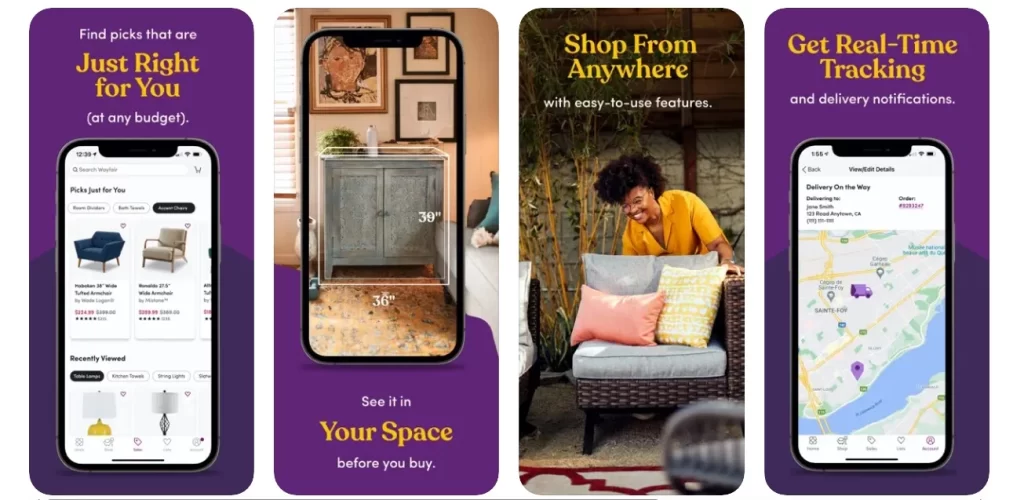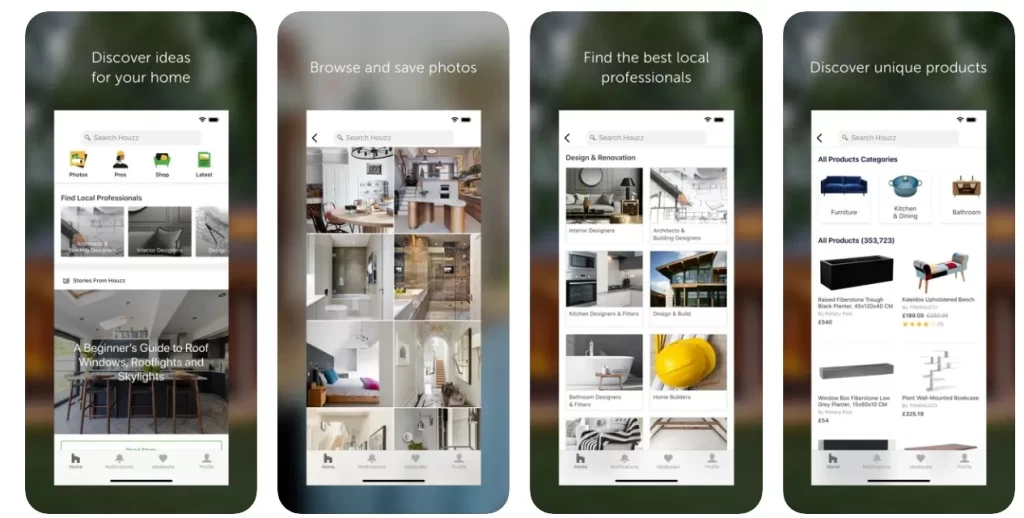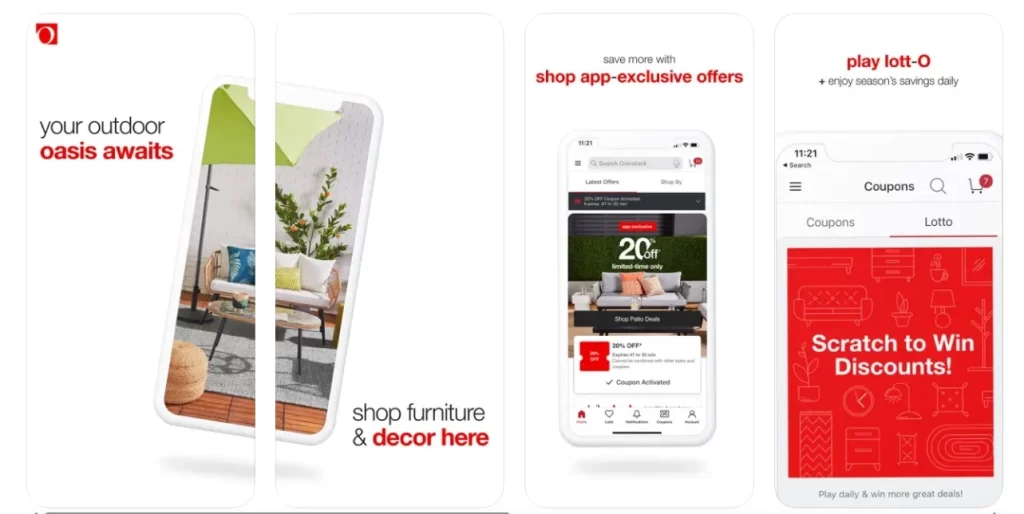
The augmented reality shopping apps offer an innovative and immersive way for users to visualize and experience furniture in their spaces.
With the increasing usage of augmented reality-based shopping apps, users can explore and interact with virtual furniture in real-time.
Moreover, these applications leverage the capabilities of smartphones, tablets, and other augmented reality-enabled devices to visualize and place virtual furniture across their rooms and make informed decisions. With the rising trend of using AR-based furniture shopping apps, investing in this market can be a lucrative option for investors looking for the next best investment.
The market size of augmented reality in retail was valued at $ 2353.99 M in 2021 and is expected to reach $23462.15 M by 2030, growing at a CAGR of 43% from 2022 to 2030.

By looking at the above market stat, it is worth considering the potential of implementing AR technology in furniture shopping apps.
Explore the development steps, tech stack, and top-listed AR furniture shopping apps to make the right move in the world of AR-based furniture shopping apps.
What Is AR-based Furniture Shopping?
A technology that enables customers to visualize and interact with virtual furniture in real-world environments using their smartphones, tablets, or other AR-enabled devices. Customers can utilize various AR-based furniture apps to access a wide range of furniture and virtually place them across their rooms.
The AR-based furniture apps utilize a device camera to overlay furniture into the live camera feed, creating an interactive and realistic representation of how the furniture would look in the actual space.
The users can access parameters such as style, size, and color of furniture to get a visual idea about the furniture in their rooms.
How AR-Based Furniture Shopping Apps Work?
AR-enabled furniture shopping apps blend virtual contents with a real-world environment using a combination of hardware and software components. Here is how AR technology is used in furniture shopping applications.
1. Product Catalog
The AR-based shopping platform includes a catalog of furniture items from various retailers and brands. These shopping furniture applications enable users to browse categories such as tables, chairs, sofas, beds, etc. Moreover, the catalog includes a detailed description of products, including their specifications and images.
2. Augmented Reality View
After selecting the desired furniture items from a product catalog, the AR-based shopping application activates the user’s device camera and points to the desired location where users want to place the furniture.
3. Virtual Placement
After selecting the desired furniture items from a product catalog, the AR-based shopping application activates the user’s camera and points them to the desired location where users want to place the furniture.
The application superimposed a virtual representation of types of furniture and provided an idea of how the furniture will look in the actual space.
4. Scaling and Adjustments
The augmented reality enabled furniture shopping apps allow their users to adjust the orientation, position, and size of the virtual furniture to accurately align them with a real-world environment.
5. Visual Evaluation
The user can access and adjust the other parameters of furniture such as their color, style, compatibility with existing decor, etc. Accessing and adjusting all these parameters help users to gather an idea about the visual of furniture in real space.
6. Additional Features
Shopping apps powered by augmented reality often provide additional features to enhance the shopping experience. These features may include providing an ability for users to change materials, colors, or finishes of the virtual furniture.
The users can save different placement options for comparison or can share images with others for making direct purchases of furniture throughout the app.
Top 10 AR Furniture Shopping Apps
Explore the best applications that are dominating the furniture shopping market with their AR-enabled technology.
1. IKEA Place

IKEA is one of the most popular platforms when it comes to furniture shopping apps. Users can simply scan their room or empty area on the floor, where the app will suggest furniture that suits their rooms best.
Moreover, IKEA provides a list of furniture that are similar to the furniture that is placed inside the user’s room.
- Founded in: 1943
- Founder: Ingvar Kamprad
- Available on: Web, Android & iOS
- App Downloads: 10M
- App Ratings: 4.6
- Headquarters: Delft, Netherlands
2. Amazon
Amazon offers a “View in Your Room” feature that lets users place the selected products on the floor or table to see if they fit their surroundings.
Moreover, the platform also facilitates a room decorator option where users can visualize several products simultaneously and save them as AR snapshots for later assessment.
- Founded in: 1994
- Founder: Jeff Bezos
- Available on: Web, Android & iOS
- App Downloads: 500M
- App Ratings: 4.3
- Headquarters: Bellevue, Washington, United States
3. Wayfair

Wayfair is another leading AR-based furniture shopping app. The platform improves the shopping experience by facilitating extra functionality such as body and environmental occlusions (a feature where people and objects appear in front of AR items).
The platform supports multiple planes, which help users to place objects on walls, tables, ceilings, floors, etc.
- Founded in: 2002
- Founder: Niraj Shah, Steve Conine
- Available on: Android & iOS
- App Downloads: 10M
- App Ratings: 4.8
- Headquarters: Boston, Massachusetts, United States
4. The Home Depot
The Home Depot offers a “See It In Your Home” feature where users can view 3D models of furniture by placing them in their room space. Moreover, the application enables its users to visualize refrigerators, furniture, vases, and chandeliers to let users better strategize their home decor planning.
- Founded in: 1978
- Founder: Arthur Blank, Bernard Marcus, Ken Langone, Pat Farrah, Ron Brill
- Available on: Android & iOS
- App Downloads: 10M
- App Ratings: 5.0
- Headquarters: Atlanta, Georgia, United States
5. Houzz

Using this application, users can visualize 3D images/models of furniture in their homes by clicking the “View In My Room” button. Moreover, users can also change the lighting or cover of the floor in a virtual title to get a visual idea of how it will look in real life.
- Founded in: 2009
- Founder: Adi Tatarko; Alon Cohen
- Available on: Android & iOS
- App Downloads: 10M
- App Ratings: 4.7
- Headquarters: Palo Alto, California, U.S
6. RoOomy
The application was developed for professional designers. Rooomy enables users to transform images into 3D scenes and save & share designs with clients. Thanks to their direct linking feature where clients can easily purchase items used in projects from popular platforms such as Wayfair or Amazon.
- Founded in: 2010
- Founder : Jan-Hein Pullens, Pieter Aarts
- Available on: Web & iOS
- App Downloads: N/A
- App Ratings: N/A
- Headquarters: San Jose, California, United States
7. Overstock

Overstock is a larger supplier of home decor, goods, and furniture items. The platform is a few early adopters that facilitate their users to virtually access furniture without leaving the comfort of their homes. The platform offers 3D visualization of items similar to pictures that users uploaded on the Overstock platform, through which the users can find similar products they are looking for.
- Founded in: 1999
- Founder: Patrick M. Byrne
- Available on: Web, Android & iOS
- App Downloads: 5M
- App Ratings: 4.7
- Headquarters: Midvale, Utah, United States
8. Anthropologie
The platform offers a wide range of women’s clothing, home decor, and accessories. The platform enables users to customize furniture products, such as fabric, color, style, shape, etc.
With their “Preview in a Room” button, users can get an idea about how the items will go with their room by visualizing them from different angles.
- Founded in: 1992
- Founder: Richard Hayne
- Available on: Web & iOS
- App Downloads: N/A
- App Ratings: 4.9
- Headquarters: Philadelphia, Pennsylvania, United States
9. Target

Target is a well-known platform that sells everything from electronics to groceries. The platforms enable their AR feature, known as “See it in your space,” that allows their users to visualize products virtually, just like other apps, and can adjust them by moving their position and changing their size and colors.
- Founded in: 1902
- Founder: George Dayton
- Available on: Web, Android & iOS
- App Downloads: 10M+
- App Ratings: 4.0
- Headquarters: Minneapolis, Minnesota, United States
10. Magnolia Market
Founded in 2015, the platform has partnered with Spotify to create a furniture shopping app for their store. There are various ranges of products available that users can purchase. Moreover, the platform offers an “in-store experience” where users can virtually access and buy furniture.
- Founded in: 2015
- Founder: Chip and Joanna Gaines
- Available on: Android & iOS
- App Downloads: 50K+
- App Ratings: 4.8
- Headquarters: Waco, United States
How To Develop AR Furniture Shopping App?
There is the involvement of several steps, including planning, designing, developing, and testing shopping for developing AR-based shopping applications.
Here is the overview of the development process of building AR based furniture shopping app:
1. Define Requirements
Begin your project by defining the requirement and goals of your AR furniture shopping app. Try to identify targeted platforms, key features, or any specific technologies or frameworks for developing AR-based furniture shopping platforms.
2. Design User Experience
The user experience design will help you identify how your users will access the furniture catalog, adjust settings, place virtual furniture, and make purchases throughout your app.
Designing mockups or wireframes is the best way to create the best user experience design.
3. Choose AR Development Tools
There are enormous AR development platforms and SDKs available in the market that facilitate developers with developing and employing AR functionality across online furniture shopping apps.
Consider utilizing popular AR development tools such as ARCore, Unity 3D, AR kit, AR Foundation, etc.
4. Build a Furniture Catalog
The furniture catalog will enable users to access a wide range of furniture available on your platform. Moreover, you can collaborate with furniture retailers and brands to let them sell and showcase their furniture among your app users.
5. Develop AR Features
Develop and implement various AR-related features such as camera input, object recognition, virtual furniture placements, surface detection, adjustment, and scaling to enable users to access and virtually place furniture in their rooms.
6. Implement E-commerce Functionality
Consider adding features such as payment gateway integration, shopping cart management, and order processing to enable users to purchase products such as furniture or other home decor items from your platform.
7. Backend Development & UI/UX Design
The back-end development will support your app functionality, such as user authentication, synchronization between the app and the catalog, data storage, etc.
While UI/UX design is another crucial aspect, allowing users to access the features and the functionality of an app.
There are various important key considerations that are involved while creating the UI/UX of an app, such as designing a clear and intuitive navigation structure to allow users to easily explore furniture categories, view product details, and access different sections of the app.
9. Testing and Quality Assurance
Conduct rigorous testing to identify and fix any issues or bugs throughout of furniture shopping app.
Performing compatibility and functionality testing, in addition to user acceptance testing across different devices, can help you achieve a smooth and error-free experience for your AR-based furniture shopping furniture app.
10. Deployment and Distribution
Deploying an app to preferred app stores becomes crucial to enable the scalability of online furniture apps powered by augmented reality. Follow the guidelines of popular app platforms where you consider publishing your app.
11. Maintenance and Updates
Even after the app launch, some other important aspects remain that are worth considering, such as app maintenance and updates for improving app performance and features to enhance the overall user experience.
App maintenance and updates will help your business to stay competitive by offering new features to your users on a regular basis.
There is a requirement for expertise in 3D modeling, UI/UX design, software development, and AR development for building an AR furniture shopping app.
Therefore, working with a reliable app development firm company is a way to build and deploy your AR-based shopping furniture app successfully.
Technical Stack For Developing AR Furniture Shopping App
The choice of the technical stack for building an AR-based furniture shopping app depends on various factors, including targeted platform, specific features and functionality, development team expertise, etc.
However, here are a few tools and technologies that are used for developing AR applications.
1. Augmented Reality Frameworks and SDKs
- ARKit (iOS): Apple’s ARKit is a framework for building AR experiences specifically for iOS devices.
- ARCore (Android): Google’s ARCore is a platform for creating AR applications on Android devices.
- Vuforia: Vuforia is an AR platform that provides computer vision capabilities for recognizing and tracking objects and markers.
- Unity3D: A popular game engine that also supports AR development. It provides AR development tools and cross-platform capabilities.
2. Backend Development
- Server-side development: Node.js
- Express.js: Express.js is a web application framework for Node.js that simplifies the creation of RESTful APIs.
3. Database
MongoDB or MySQL: Common tools for storing app data, including user profiles, product catalogs, and order information.
4. Programming Languages
- Swift or Objective-C: For iOS app development
- Java or Kotlin: For Android app development
5. 3D Modeling and Rendering
- Blender: Open-source 3D modeling software for creating 3D models of furniture items.
- Autodesk Maya or 3ds Max: Commercial 3D modeling and rendering software
6. E-commerce Integration
- Payment Gateways: PayPal, Stripe, or Braintree to facilitate online transactions.
- APIs: e-commerce APIs to retrieve product information
7. User Interface (UI) and User Experience (UX) Design
- Web technologies: HTML5, CSS3, and JavaScript
- UI Frameworks: Frameworks like React, Angular, or Vue.js can be used for building responsive and interactive user interfaces.
8. Cloud Services
- Cloud Storage: Amazon S3 or Google Cloud Storage for storing 3D models or images.
- Cloud Computing: Platforms like Amazon Web Services (AWS) or Google Cloud Platform (GCP) provide computing resources for backend processing or AR-related tasks.
Remember that the specific technical stack may vary depending on your project requirements, team expertise, and other factors.
Therefore, it’s important to assess the specific needs of your AR furniture shopping app and choose the technologies that best align with your goals.
Conclusion
Choosing the right kind of furniture is not a piece of cake. Thanks to augmented reality helping users get an idea of how the furniture would look in a real space.
With the growing demand of such kind of applications, developing your own furniture shopping app powered by AR is a way to tap into this profitable market.
However, there is a requirement for expertise across the various domain of application development, such as programming, API integration, augmented reality implementation & development, etc.
Therefore, working with our reliable app development company can be your best move to easily build and launch your AR-based furniture shopping app to your targeted market.
Partner with Idea Usher if you are looking for an app development firm that can help you with identifying your project, building your AR-based furniture shopping application and deploying them to your targeted market.
FAQ
Q. How can AR apps be used in home shopping?
A. The applications enable their customers to view products or experience services in their own environment by virtually placing items across their rooms.
Q. What are the benefits of augmented reality in customer experience?
A. Augmented reality offers various benefits to users, such as giving them ideas about how the product will look in their room and helping them make an informed decision by allowing them modifying products’ various parameters such as color, size, shape, etc.
Q. What is the best AR furniture shopping app?
A. There are many best AR-based furniture shopping apps available in the market such as Amazon, Wayfair, IKEA Place, The Home Depot, house, roomy Mongolia Market, and Overstock.








Gaurav Patil